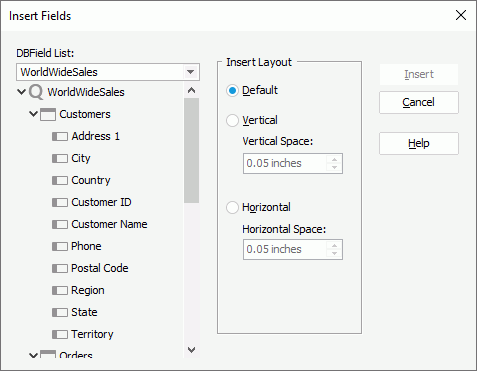Working with Formula Fields
Formulas are calculated from DBFields, other formulas, summaries, and parameters. This topic introduces how you can insert formula fields in a report and add conditional formatting to the formula fields.
For the formula fields in a report, you can use them as the trigger object of links, and change their display types if you want.
This topic contains the following sections:
See an example: The SampleComponents catalog, included with Designer, contains reports that have examples of how you could use each component type in a report. For the formula field example, open <install_root>\Demo\Reports\SampleComponents\UsingFormula.cls.
Inserting Formula Fields in a Report
You can insert formula fields in the report areas listed in Component Placement in Different Report Type.
For a business view-based report
In the Data panel, select the formula from the Dynamic Resources > Formulas node and drag it to the destination.
For a query-based report
You can insert a formula field into a query-based report using either of the following two methods:
- By dragging and dropping
In the Data panel, select a dataset from the dataset drop-down list, then select the formula from the Formulas node and drag it to the destination. When the predefined formulas are not what you want, you can select <New Formula...> to create a formula. - Using dialog box
- Position the mouse pointer at the destination where you want to insert the formula.
- Navigate to Insert > Formula or Home > Insert > Formula. Designer displays the Insert Fields dialog box.

- Select a dataset from the dataset drop-down list. Designer then lists all resources in the specified dataset. However, if you are inserting formula fields into a data component, you should not change the dataset. You can only apply one dataset in a data component.
- Select the formula you need from the Formulas node. You can select multiple formulas to insert them all at a time.
- When you select multiple formulas, in the Insert Layout box, specify the layout of the formula fields in the report. By default, Designer arranges them in the default layout. You can arrange the formula fields horizontally or vertically by selecting Horizontal or Vertical, and customize the space between them.
- Select Insert to insert the formula fields into the destination.
![]()
- In a query-based report, not all formulas in the catalog are valid in the current context, so under the Formulas node in the Insert Fields dialog box or the Data panel, Designer only lists the valid formulas that are based on DBFields from the current dataset.
- If you insert a formula into the detail panel of a data component, Designer automatically inserts its name as a label into the corresponding header panel; otherwise, Designer places the formula and its name label in the same panel. If you do not want Designer to insert the name label automatically, clear "Insert field name label with field" in the Component category of the Options dialog box.
Adding Conditional Formatting to Formula Fields
You can add conditional formatting to formula fields in a report, so the field values that meet a specified condition can automatically apply the formatting you define for the condition. This is very useful to highlight values that users may need to act on at runtime.
To apply conditional formatting to a formula field, right-click it and select Conditional Formatting from the shortcut menu, then take the same procedure as described in Adding Conditional Formatting to DBFields.
 Previous Topic
Previous Topic
 Back to top
Back to top